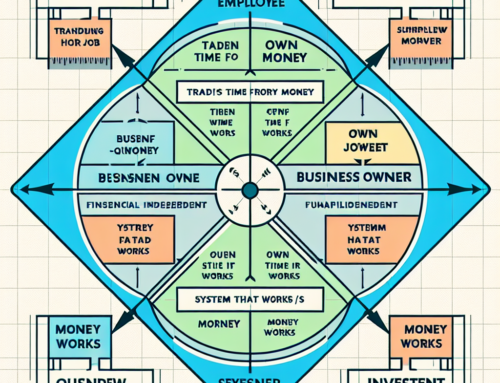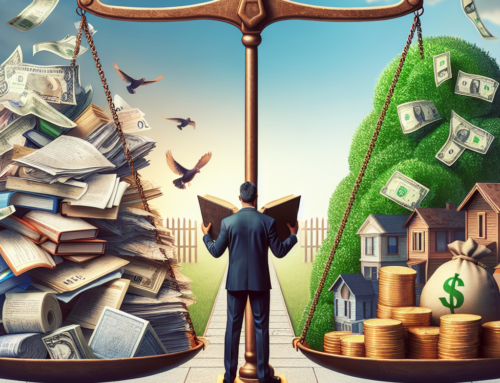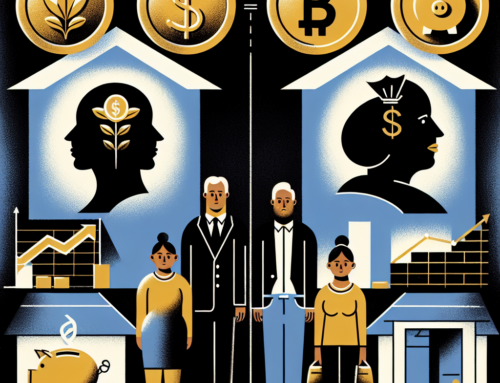
Understanding The Importance Of Financial Education
”Rich Dad Poor Dad” by Robert Kiyosaki has become a cornerstone in the realm of personal finance literature, offering invaluable lessons on financial education. The book juxtaposes the financial philosophies of Kiyosaki’s two father figures: his biological father, whom he refers to as his ”Poor Dad,” and the father of his best friend, whom he calls his ”Rich Dad.” Through their contrasting approaches to money, Kiyosaki underscores the importance of financial education, a subject often overlooked in traditional schooling.
One of the most compelling lessons from ”Rich Dad Poor Dad” is the distinction between assets and liabilities. Kiyosaki emphasizes that understanding this difference is crucial for financial success. While his Poor Dad believed in working hard for a stable job and saving money, his Rich Dad taught him to invest in assets that generate income. This fundamental principle encourages readers to focus on acquiring assets such as real estate, stocks, and businesses, which can provide financial stability and growth over time. By doing so, individuals can create multiple streams of income, reducing their dependence on a single paycheck.
Moreover, Kiyosaki’s book highlights the significance of financial literacy. He argues that traditional education systems fail to teach students about money management, leaving them ill-prepared for real-world financial challenges. Through the experiences of his Rich Dad, Kiyosaki learned the importance of understanding financial statements, tax laws, and investment strategies. This knowledge empowered him to make informed decisions and seize opportunities that others might overlook. Consequently, the book encourages readers to seek out financial education through books, seminars, and mentors, fostering a proactive approach to managing their finances.
In addition to financial literacy, ”Rich Dad Poor Dad” advocates for a mindset shift. Kiyosaki’s Rich Dad instilled in him the belief that one should work to learn, not just to earn. This perspective encourages individuals to view their jobs as opportunities for acquiring new skills and knowledge, rather than merely a means to a paycheck. By continuously learning and adapting, individuals can enhance their value in the marketplace and open doors to new opportunities. This mindset also fosters resilience, as it encourages people to embrace challenges and view failures as learning experiences rather than setbacks.
Furthermore, the book underscores the importance of taking calculated risks. Kiyosaki’s Rich Dad taught him that playing it safe can often lead to missed opportunities. While his Poor Dad preferred the security of a steady job, his Rich Dad believed in the potential rewards of entrepreneurship and investment. This lesson encourages readers to step out of their comfort zones and explore new ventures, whether it’s starting a business, investing in real estate, or entering the stock market. By taking informed risks, individuals can achieve financial independence and create wealth over time.
Lastly, ”Rich Dad Poor Dad” emphasizes the value of financial independence. Kiyosaki’s Rich Dad believed that true wealth is measured by the ability to live comfortably without relying on a traditional job. This lesson inspires readers to strive for financial freedom by building passive income streams and reducing liabilities. By doing so, individuals can gain control over their time and resources, allowing them to pursue their passions and live life on their own terms.
In conclusion, ”Rich Dad Poor Dad” offers a wealth of knowledge on the importance of financial education. Through the contrasting philosophies of his two father figures, Robert Kiyosaki provides readers with practical lessons on distinguishing between assets and liabilities, seeking financial literacy, adopting a growth mindset, taking calculated risks, and striving for financial independence. These lessons serve as a valuable guide for anyone looking to improve their financial well-being and achieve long-term success.
The Difference Between Assets And Liabilities
In ”Rich Dad Poor Dad,” Robert Kiyosaki introduces readers to a fundamental concept that can transform their financial understanding: the difference between assets and liabilities. This distinction is crucial for anyone looking to achieve financial independence and build wealth over time. Kiyosaki’s teachings emphasize that understanding and applying this knowledge can lead to significant changes in one’s financial health.
To begin with, Kiyosaki defines assets as things that put money in your pocket, while liabilities are things that take money out of your pocket. This straightforward definition helps to clarify why some people struggle financially despite having high incomes. For instance, many individuals believe that their homes are their greatest assets. However, Kiyosaki argues that if a home requires constant expenses such as mortgage payments, maintenance, and taxes, it is actually a liability. This perspective challenges conventional wisdom and encourages readers to re-evaluate their financial decisions.
Transitioning from this foundational idea, Kiyosaki further explains that the key to financial success lies in acquiring assets that generate income. These can include investments such as stocks, bonds, real estate, and businesses. By focusing on building a portfolio of income-generating assets, individuals can create multiple streams of revenue, which can provide financial security and freedom. This approach contrasts sharply with the common practice of accumulating liabilities, such as expensive cars, luxury items, and other depreciating assets, which can drain financial resources over time.
Moreover, Kiyosaki’s lessons highlight the importance of financial education. He stresses that many people lack the knowledge needed to distinguish between assets and liabilities, which can lead to poor financial choices. By educating oneself about financial principles and investing wisely, individuals can make informed decisions that contribute to long-term wealth. This educational journey often involves learning about different types of investments, understanding market trends, and developing a mindset geared towards financial growth.
In addition to financial education, Kiyosaki emphasizes the role of mindset in achieving financial success. He contrasts the mindset of his ”Rich Dad,” who focused on acquiring assets and building wealth, with that of his ”Poor Dad,” who prioritized job security and traditional career paths. This comparison illustrates how one’s beliefs and attitudes towards money can significantly impact financial outcomes. Adopting a mindset that prioritizes asset acquisition and financial independence can lead to more strategic and effective financial planning.
Furthermore, Kiyosaki’s teachings encourage readers to take control of their financial destinies. He advocates for proactive financial management, which involves regularly assessing one’s financial situation, setting goals, and making adjustments as needed. This proactive approach can help individuals stay on track towards their financial objectives and avoid common pitfalls associated with poor financial management.
In conclusion, the lessons learned from Robert Kiyosaki’s ”Rich Dad Poor Dad” regarding the difference between assets and liabilities are invaluable for anyone seeking to improve their financial situation. By understanding and applying the concepts of asset acquisition, financial education, and a proactive mindset, individuals can pave the way towards financial independence and long-term wealth. Kiyosaki’s insights challenge conventional wisdom and provide a fresh perspective on how to achieve financial success, making them essential reading for anyone looking to take control of their financial future.
The Power Of Entrepreneurship And Business Ownership
Robert Kiyosaki’s ”Rich Dad Poor Dad” has become a cornerstone in the world of personal finance literature, offering invaluable lessons on the power of entrepreneurship and business ownership. The book contrasts the financial philosophies of Kiyosaki’s two father figures: his biological father, whom he refers to as his ”Poor Dad,” and the father of his best friend, whom he calls his ”Rich Dad.” Through their differing perspectives, Kiyosaki illustrates the profound impact that mindset and education can have on one’s financial success.
One of the most compelling lessons from ”Rich Dad Poor Dad” is the importance of financial education. Kiyosaki emphasizes that traditional schooling often fails to teach students about money management, investing, and entrepreneurship. His ”Rich Dad” advocates for self-education and continuous learning, encouraging individuals to seek knowledge outside the conventional classroom. This lesson underscores the idea that financial literacy is a crucial skill that can empower individuals to make informed decisions and seize opportunities that others might overlook.
Transitioning from the concept of financial education, Kiyosaki delves into the significance of entrepreneurship. He argues that owning a business can provide a level of financial freedom and security that traditional employment cannot. While a steady job offers a predictable income, it often comes with limitations on earning potential and personal growth. In contrast, entrepreneurship allows individuals to leverage their skills, creativity, and resources to build something of their own. This path, though fraught with risks, can lead to greater rewards and a sense of fulfillment that is hard to achieve through conventional employment.
Kiyosaki’s ”Rich Dad” teaches him that the key to financial success lies in acquiring assets that generate income. This lesson is pivotal in understanding the power of business ownership. By investing in assets such as real estate, stocks, or a business, individuals can create multiple streams of income that work for them, even when they are not actively working. This concept of passive income is a cornerstone of Kiyosaki’s philosophy, highlighting the potential for financial independence through smart investments and business ventures.
Moreover, Kiyosaki emphasizes the importance of taking calculated risks. Entrepreneurship inherently involves uncertainty, but it also offers the potential for significant rewards. His ”Rich Dad” encourages him to embrace challenges and view failures as learning opportunities. This mindset shift is crucial for aspiring entrepreneurs, as it fosters resilience and adaptability. By understanding that setbacks are part of the journey, individuals can persevere and ultimately achieve their financial goals.
In addition to these lessons, Kiyosaki also highlights the value of networking and mentorship. His relationship with his ”Rich Dad” serves as a testament to the impact that a knowledgeable mentor can have on one’s financial education and entrepreneurial journey. Building a network of like-minded individuals and seeking guidance from experienced mentors can provide invaluable insights and support, helping entrepreneurs navigate the complexities of business ownership.
In conclusion, ”Rich Dad Poor Dad” offers a wealth of knowledge on the power of entrepreneurship and business ownership. Through the contrasting philosophies of his two father figures, Kiyosaki illustrates the importance of financial education, the benefits of owning a business, the value of acquiring income-generating assets, the necessity of taking calculated risks, and the significance of networking and mentorship. These lessons serve as a roadmap for individuals seeking to achieve financial independence and success through entrepreneurship. By embracing these principles, readers can transform their mindset and take proactive steps towards building a prosperous future.
The Role Of Mindset In Achieving Financial Success
In ”Rich Dad Poor Dad,” Robert Kiyosaki delves into the contrasting financial philosophies of his two father figures, which ultimately shaped his understanding of wealth and success. One of the most compelling lessons from the book is the pivotal role that mindset plays in achieving financial success. Kiyosaki’s narrative underscores that the way we think about money, investments, and opportunities can significantly influence our financial outcomes.
To begin with, Kiyosaki introduces us to his ”Poor Dad,” his biological father, who was highly educated and worked diligently in a stable job. Despite his hard work and dedication, Poor Dad struggled financially, often emphasizing the importance of job security and a steady paycheck. In contrast, Kiyosaki’s ”Rich Dad,” his best friend’s father, had a different approach. Rich Dad, who lacked formal education but possessed a keen business acumen, believed in the power of financial education and entrepreneurship. This dichotomy between the two fathers’ mindsets serves as a foundation for Kiyosaki’s exploration of financial success.
One of the key takeaways from Rich Dad’s philosophy is the importance of financial literacy. Rich Dad taught Kiyosaki that understanding how money works is crucial for building wealth. This includes knowledge about assets, liabilities, income, and expenses. By focusing on acquiring assets that generate passive income, rather than merely working for a paycheck, individuals can create a sustainable financial future. This shift in mindset from earning to investing is a fundamental lesson that Kiyosaki emphasizes throughout the book.
Moreover, Kiyosaki highlights the significance of taking risks and embracing failure as part of the learning process. Rich Dad encouraged Kiyosaki to view failures not as setbacks but as valuable lessons that contribute to personal and financial growth. This perspective fosters resilience and a willingness to step out of one’s comfort zone, which are essential traits for achieving financial success. By contrast, Poor Dad’s fear of failure and preference for stability often limited his financial opportunities.
Another critical aspect of mindset that Kiyosaki discusses is the concept of self-discipline and delayed gratification. Rich Dad instilled in Kiyosaki the importance of managing one’s desires and focusing on long-term goals. This involves making conscious decisions to invest in assets and education rather than indulging in immediate pleasures. The ability to delay gratification and prioritize future financial security over short-term satisfaction is a hallmark of a wealth-building mindset.
Furthermore, Kiyosaki emphasizes the value of continuous learning and adaptability. In a rapidly changing economic landscape, staying informed and adaptable is crucial. Rich Dad’s mindset of lifelong learning and openness to new ideas enabled him to seize opportunities and navigate financial challenges effectively. This contrasts with Poor Dad’s more rigid approach, which often left him unprepared for economic shifts.
In conclusion, ”Rich Dad Poor Dad” offers invaluable insights into the role of mindset in achieving financial success. Through the contrasting philosophies of his two father figures, Kiyosaki illustrates that financial literacy, risk-taking, resilience, self-discipline, and continuous learning are essential components of a wealth-building mindset. By adopting these principles, individuals can transform their financial outlook and work towards a more prosperous future. The lessons from Kiyosaki’s book serve as a reminder that our thoughts and attitudes towards money can profoundly impact our financial destiny.
The Value Of Investing In Real Estate
In ”Rich Dad Poor Dad,” Robert Kiyosaki emphasizes the importance of financial education and the value of investing in real estate. One of the key lessons from the book is the distinction between assets and liabilities. Kiyosaki’s ”rich dad” taught him that assets are things that put money in your pocket, while liabilities take money out. Real estate, when managed wisely, can be a powerful asset that generates passive income and builds wealth over time.
Kiyosaki’s approach to real estate investing is rooted in the idea of making your money work for you. Unlike traditional employment, where income is directly tied to the number of hours worked, real estate investments can generate income even when you’re not actively involved. This concept of passive income is crucial for achieving financial independence. By investing in properties that appreciate in value and generate rental income, you can create a steady stream of revenue that supports your financial goals.
Moreover, Kiyosaki highlights the importance of leveraging other people’s money (OPM) to invest in real estate. This strategy involves using borrowed funds to purchase properties, thereby amplifying your potential returns. While this approach carries risks, it also offers significant rewards when executed correctly. By carefully selecting properties with strong potential for appreciation and rental income, you can use OPM to build a robust real estate portfolio without needing substantial upfront capital.
Another valuable lesson from ”Rich Dad Poor Dad” is the importance of financial literacy. Kiyosaki stresses that understanding financial statements, market trends, and investment strategies is essential for successful real estate investing. He encourages readers to continually educate themselves and seek out mentors who can provide guidance and insights. By developing a solid foundation of financial knowledge, you can make informed decisions and avoid common pitfalls that many novice investors encounter.
In addition to financial literacy, Kiyosaki underscores the significance of due diligence. Before investing in any property, it’s crucial to conduct thorough research and analysis. This includes evaluating the property’s location, condition, and potential for appreciation. Additionally, understanding the local real estate market and economic factors that could impact property values is essential. By performing due diligence, you can mitigate risks and increase the likelihood of a successful investment.
Furthermore, Kiyosaki advocates for a long-term perspective when it comes to real estate investing. While short-term gains can be enticing, the true value of real estate often lies in its potential for long-term appreciation and income generation. By holding onto properties and allowing them to appreciate over time, you can build substantial wealth and create a legacy for future generations. This long-term approach requires patience and discipline, but it can yield significant rewards.
Lastly, Kiyosaki emphasizes the importance of taking action. While knowledge and planning are essential, they must be accompanied by decisive action to achieve success. Many people hesitate to invest in real estate due to fear or uncertainty, but Kiyosaki encourages readers to overcome these obstacles and take the first step. By starting small and gradually building your portfolio, you can gain experience and confidence, ultimately leading to greater financial success.
In conclusion, ”Rich Dad Poor Dad” offers valuable insights into the benefits of investing in real estate. By understanding the distinction between assets and liabilities, leveraging other people’s money, prioritizing financial literacy, conducting due diligence, adopting a long-term perspective, and taking decisive action, you can harness the power of real estate to achieve financial independence and build lasting wealth.
We have lots of exciting coming events in Entrepreneurship, Investing and Personal Development. You can find them all here:
www.swedishwealthinstitute.se/events




